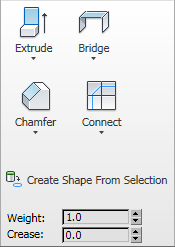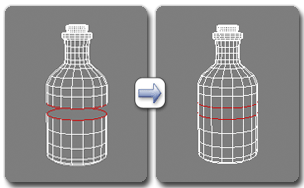A border is a linear section of a mesh that can generally be described as the edge of a hole. This is usually a sequence of edges with polygons on only one side. For example, a box primitive doesn't have a border, but the teapot object has several: on the lid, on the body, on the spout, and two on the handle. If you create a cylinder and then delete an end polygon, the adjacent row of edges forms a border.
At the editable poly Border sub-object level, you can select single and multiple borders and transform them using standard methods.
Interface

-
 Extrude
Extrude - Lets you extrude a border manually via direct manipulation in the viewport. Click this button, and then drag vertically on any border to extrude it.
Extruding a border moves it along a normal and creates new polygons that form the sides of the extrusion, connecting the border to the object. The extrusion can form a varying number of additional sides, depending on the geometry near the border. As you increase the length of the extrusion, the base increases in size, to the extent of the vertices adjacent to the extruded border's endpoints.
Following are important aspects of border extrusion:
- When the mouse cursor is over a selected border, it changes to an Extrude cursor.
- To specify the extent of the extrusion, drag vertically, and to set the size of the base, drag horizontally.
- With multiple borders selected, dragging on any one extrudes all selected borders equally.
- While the Extrude button is active, you can extrude other borders in turn by dragging them. Click Extrude again or right-click in the active viewport to end the operation.
Note: To open the Extrude Edges dialog, choose Extrude Settings from the drop-down menu or Shift+click the Extrude button. - Extrude Settings (on Extrude drop-down)
- Opens the Extrude Edges caddy, which lets you perform extrusion via interactive manipulation.
If you click this button after performing a manual extrusion, the same extrusion is performed on the current selection as a preview and the caddy opens with Extrusion Height set to the amount of the last manual extrusion.
-
 Bridge
Bridge
- Connects pairs of borders on an object with polygon “bridges.” There are two ways to use Bridge in Direct Manipulation mode (that is, without opening the Bridge Settings dialog):
- Select an even number of borders on the object, and then click Bridge. This immediately creates the bridge between each pair of selected borders using the current Bridge settings, and then deactivates the Bridge button.
- If no qualifying selection exists (that is, two or more selected borders), clicking Bridge activates the button and places you in Bridge mode. First click a border edge and then move the mouse; a rubber-band line connects the mouse cursor to the clicked edge. Click a second edge on a different border to bridge the two. This creates the bridge immediately using the current Bridge settings; the Bridge button remains active for connecting more pairs of borders. To exit Bridge mode, right-click the active viewport or click the Bridge button.
The new polygons that result from a Bridge operation are selected automatically; you can see this by accessing the Polygon sub-object level.

Using Bridge at the Border level.
Note: Bridge always creates a straight-line connection between border pairs. To make the bridge connection follow a contour, apply modeling tools as appropriate after creating the bridge. For example, bridge two borders, and then use Bend.Note: To open the Bridge Borders dialog, choose Bridge Settings from the drop-down menu or Shift+click the Bridge button. - Bridge Settings (on Bridge drop-down)
- Opens the Bridge caddy, which lets you connect pairs of borders via interactive manipulation.
-
 Chamfer
Chamfer - Click this button and then drag a border in the active object. The border need not be selected first.
If you chamfer multiple selected borders, all of them are chamfered identically. If you drag an unselected border, any selected borders are first deselected.
A border chamfer essentially “frames” the border edges, creating a new set of edges paralleling the border edges, plus new diagonal edges at any corners. These new edges are exactly <chamfer amount> distance from the original edges. New chamfer faces are created with the material ID of one of the neighboring faces (picked at random) and a smoothing group which is an intersection of all neighboring smoothing groups.
Alternatively, you can create open space around the chamfered borders, essentially cutting away at the open edges; for details, see Chamfer.
Note: To open the Chamfer Edges dialog, choose Chamfer Settings from the drop-down menu or Shift+click the Chamfer button. - Chamfer Settings (on Chamfer drop-down)
- Opens the Chamfer Edges caddy, which lets you chamfer borders via interactive manipulation and toggle the Open option.
If you click this button after performing a manual chamfer, the same chamfer is performed on the current selection as a preview and the dialog opens with Chamfer Amount set to the amount of the last manual chamfer.
-
 Connect
Connect
- Creates new edges between pairs of selected border edges. The edges are connected from their midpoints.
You can connect only edges on the same polygon.
Connect will not let the new edges cross. Thus, for example, if you select all four edges of a four-sided polygon and then click Connect, only neighboring edges are connected, resulting in a diamond pattern.
Note: To open the Connect Edges dialog, choose Connect Settings from the drop-down menu or Shift+click the Connect button. - Connect Settings (on Connect drop-down)
- Lets you preview the Connect and specify the number of edge segments created by the operation. To increase the mesh resolution around the new edge, increase the Connect Edge Segments setting.
-
 Create Shape From Selection
Create Shape From Selection - After selecting one or more borders, click this button to create a spline shape from the selected edges. A Create Shape dialog appears, letting you name the shape and set it to Smooth or Linear. The new shape's pivot is placed at the center of the poly object.
- Weight
- Sets the weight of selected borders. Used by the
NURMS subdivision option.
Increasing an edge weight tends to push the smoothed result away.
- Crease
- Specifies how much creasing is performed on the selected border or borders. Used by the
NURMS subdivision option.
At low settings, the border is relatively smooth. At higher settings, the crease becomes increasingly visible. At 1.0, the highest setting, the border is not smoothed at all.